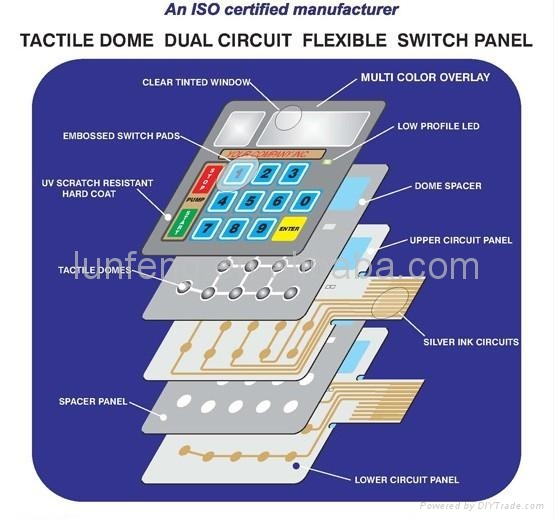How Membrane Switches Are Shaping the Future of Electronic Interfaces
How Membrane Switches Are Shaping the Future of Electronic Interfaces
Blog Article
Comprehending Membrane Layer Switches Over: The Trick to Trustworthy and long lasting Controls

What Are Membrane Layer Switches?
Membrane layer switches are a sophisticated service in the world of individual interface technology, integrating capability and style perfectly. These gadgets function as an interface between users and digital systems, integrating several parts into a small style. Generally built from flexible, thin layers of materials, membrane layer switches are made to reply to touch, making it possible for users to engage with equipment and digital devices effectively.
The key aspects of a membrane button consist of a published circuit layer, graphic overlay, and a spacer layer that avoids unexpected activation. The graphic overlay can be tailored to show brand name identification or customer preferences, enhancing looks while making certain functionality. Membrane switches are frequently made use of in numerous applications, consisting of medical tools, customer electronic devices, and commercial equipment, owing to their longevity and resistance to environmental aspects such as moisture and dirt.
Among the essential advantages of membrane switches is their capacity to hold up against deterioration, making them suitable for high-traffic atmospheres. Furthermore, they are light-weight and require very little area, allowing for ingenious designs in product advancement. In general, membrane layer changes represent a reliable and sensible selection for contemporary digital interfaces, marrying innovation with user-centric layout concepts.
Exactly How Membrane Layer Switches Over Work
The procedure of membrane changes joints on a straightforward yet reliable mechanism that converts individual input right into electronic signals. When an individual presses the switch, the leading layer flaws, permitting a conductive component in the circuit layer to make contact with a matching conductive pad on the underside of the visuals overlay.
The design of membrane buttons can differ, however they usually incorporate domes or responsive elements to supply comments to the individual, enhancing the overall experience - membrane switch. The products made use of in membrane switches, such as polyester or polycarbonate, add to their toughness and resistance to environmental factors, including dampness and dust. Moreover, the printed circuits are normally enveloped, which shields them from deterioration in time.
Advantages of Membrane Switches

Additionally, membrane layer buttons are understood for their resilience. Built from robust products, they are immune to dust, dampness, and physical wear, which dramatically extends their life expectancy contrasted to standard mechanical switches. other This toughness makes them especially appropriate for high-traffic settings and applications needing long life.
Another considerable advantage is the ease of cleaning and maintenance. The smooth surface area of membrane switches over minimizes dust accumulation and is usually impervious to spills, making them ideal for settings that call for constant sanitization.
In addition, membrane layer buttons use a structured profile, causing a thinner layout that can be integrated into different devices without adding mass. This feature not only improves the visual charm but additionally adds to a more ergonomic product layout.
Applications of Membrane Layer Buttons
Versatile and easy to use, membrane buttons find applications across a vast array of sectors, consisting of clinical devices, consumer electronic devices, and industrial tools. In the clinical area, these buttons are important to devices such as diagnostic devices, individual surveillance systems, and infusion pumps, where reliability and ease of cleaning are crucial. Their capacity to stand up to harsh settings and keep performance makes them excellent for such applications.

In consumer electronics, membrane layer buttons are utilized in products like microwaves, cleaning makers, and remote controls - membrane switch. Their streamlined design permits user-friendly interface, improving the total individual experience while giving sturdiness and resistance to damage
Commercial devices also benefits from membrane layer buttons, specifically in control panels for equipment and automation systems. These buttons offer protection against dust and dampness, ensuring regular performance in tough environments. Furthermore, their customizable attributes allow makers to tailor them to certain operational requirements, enhancing effectiveness and functionality.
Choosing the Right Membrane Layer Change
When selecting a membrane button, it is crucial to consider numerous elements that affect efficiency and suitability for certain applications. The key considerations consist of environmental problems, responsive feedback, resilience, and design specifications.
First, assess the operating setting; switches exposed to wetness, chemicals, or extreme temperatures call for details products to make sure longevity read review and functionality. Next, assess the demand for tactile responses. Depending on user communication, some applications Get the facts may gain from a tactile action to verify activation, while others might prefer a non-tactile layout for aesthetic reasons.
Sturdiness is another crucial factor; membrane switches ought to be created to hold up against frequent use, impacts, and abrasion. Make sure the chosen button can withstand the expected lifecycle, specifically in high-usage circumstances.

Final Thought
Finally, membrane switches over act as crucial parts in the design of resilient and reputable control systems throughout numerous industries. Their small layout, combined with robust construction and customizable attributes, boosts user communication while making sure durability in demanding settings. The versatility of membrane switches permits customized options that satisfy particular functional requirements, reinforcing their relevance in modern technology. As sectors remain to progress, the value of incorporating effective membrane switch services can not be overemphasized.
Membrane switches over represent a vital element of modern-day interface layout, mixing functionality with durability in different applications.Membrane switches are an innovative remedy in the world of user interface modern technology, integrating performance and layout flawlessly. Normally built from versatile, thin layers of products, membrane layer buttons are made to respond to touch, enabling users to connect with equipment and digital devices successfully.
The design of membrane buttons can differ, but they commonly incorporate domes or tactile aspects to offer responses to the user, enhancing the total experience.In final thought, membrane switches over serve as essential components in the design of resilient and reputable control systems across different markets.
Report this page